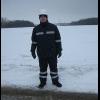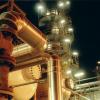|
|

#1

Posted 29 March 2012 - 03:02 AM
I have my gas components:
methane 86.389
ethane 7.858
propane 3.476
i-butane 0.220
n-butane 0.487
neopentane 0.005
i-pentane 0.057
n-pentane 0.055
C6+ 0.093
nitrogen 0.689
CO2 0.669
Helium -
Hydrogen 0.00
Oxigen 0.002
at pressure 3.7 MPa, -7 C
After well testing in test 3 ph. separator we got:
gas -182.8 mmscf/day
oil - 32.8 bbls/day
water- 0.5 bbls/day
Now I am trying to make a model in Hysys, and my question is - I haven't got any water in the separator in Hysys in Heavy liquid stream.
But in real separator we got 0.5 bbls/day water. Second question - there is no water in gas composition, may be this a reason?
Please help, rhanks
#2

Posted 29 March 2012 - 03:45 AM
We should always remember that whatever software we are using in our computer, it processes information based on "Garbage In=Garbage Out" rule. So if you have not included water in the composition, how hysys will come to know about it? You are probably expecting too much from your computer.
What you need to do is to add another stream with 100% water composition and mix it with your gas. Now change the flow rate until you get 0.5 b/d in the heavy liquid stream of the separator.
Hope this helps.
#3

Posted 29 March 2012 - 03:56 AM
Yes I added water stream.
I have 0.05 vol% oil BSW after my real separator (data from report). So I got 99.95 % oil and 0.05 water in my light liquid (oil)?
So I need to specify carry over 0.05 - light liquid in heavy liquid?
Regards
#4

Posted 30 March 2012 - 02:06 AM
according my experience this is a quite common problem in natural gas industry and several thermodynamic models are available for this task, for example in my copy of Prode Properties (see prode.com) these specific model are available for natural gas with water,
-GERG 2004 (which is now the standard ISO 18453)
-Peng Robinson with complex mixing rules as Wong Sandler
-Cubic Plus Association
-SAFT with association
your simulator may include one or more of these models,
when possible I prefer Cubic Plus Association (which is however a bit slow to converge cause the additional solver for the association part) but Gerg is also good (over the temperature range specified in standard) and very fast.
In addition, the availability of a data regression procedure is useful if you to fit experimental data.
Edited by PaoloPemi, 30 March 2012 - 02:09 AM.
#5

Posted 30 March 2012 - 02:18 AM
Attached Files
#6

Posted 31 March 2012 - 02:53 AM
I think it would be useful for us to get a practical example where the "old" method of adding a little amount of water (qty to keep very low the residual water -liquid phase- in condensate as result of a isothermal flash, usual practice being to make one or two attempts ) does produce a wrong gas composition.
By the way in many cases one knows a priori (from gas analysis) the real content of water entering the plant (as it may be the case of Dmitry),
then thermodynamics should do the right work,
if not it may be that a saturation unit can reduce problems (refitting a composition),
but there are other problems.
#8

Posted 29 April 2012 - 10:24 AM
All natural Gas from gas wells is water saturated. The earliest chart for calculating water in sweet natural gas was by McKetta & Wehe published in 1958 and subsequently reproduced in the GPSA Engineering Databook. Besides the part of modeling water in natural gas in HYSYS you can refer a discusssion on water content in natural gas at the following link:
http://www.cheresour...of-natural-gas/
Regards,
Ankur.
#9

Posted 08 May 2012 - 03:24 AM
i prefer to model these things with Hysys upstream options and for characterization of oil-water-gas go for Neotec Black Oil methods and thermodynamics. Saturate unit operation will give you the equilibrium water content of oil and gas at that P,T but what about the water make at three phase separator?
#10

Posted 22 October 2013 - 08:54 AM
- I'm not expert in this issues and I'm trying to build a Hysys model, please could someone send me the procedure step by step (for dummy) to use Saturate Link to add water in gas stream composition. I read the Saturate User Guide.doc, but it is not clear for me.
#11

Posted 22 October 2013 - 09:28 AM
LuisHuaranga,
as said by others before, usually the problem is not a saturation unit
(basically you can solve that as isothermal flash,
one can do that without specific modules)
but the accuracy of VLE model,
if you plan to use a std. EOS the errors
(mainly on water fractions in vapor and liquid phases)
will be probably high and results unreliable,
you can easily compare dew points as
calculated for mixtures of +90% C1 and Water
with a std. EOS and constant BIP errors can
exceed 5 K,
with a EOS including specific alpha parameters
and temperature dependent BIPs
errors can be about 1K (max)
in a reasonable range of temperatures,
examples (which I know, there could be others)
are ISO 18453 or the Extended EOS models
with temperature dependent BIPs
available in Prode Properties,
Aspen (which I don't know well) includes many models,
I would select and validate the best model as first step,
once you have calculated and evaluated some VLE points
(for example by comparing with GPA data)
you shouldn't find problems to saturate
a stream with water and verify the results...
Edited by PaoloPemi, 22 October 2013 - 10:06 AM.
#12

Posted 23 October 2013 - 11:22 PM
Hi Luis,
The saturate utility is an extension in HYSYS,
To add an extension to your flowsheet,
Click on the menu bar item "Flowsheet"
Head down to "add operation", (or shortcut key, F12)
select the radio button "extensions
Select "Saturate with Water"
If this extensions is not showing up in the list, it needs to be installed, you can get it from Aspentech support
http://support.aspen...B.asp?ID=110073
This sould have the required instructions to register the extension for use etc..
Click add.
A shower looking icon will be added to your flowsheet.
Then its a means of hooking up your gas stream and adding a water stream to the top connector.
Hope this is what you were after about the step by step guide.
Similar Topics
Tank Blanketing With Natural Gas/ Vapor Recovery SystemStarted by Guest_MethanolPlant_* , Today, 08:17 AM |
|

|
||
Waste WaterStarted by Guest_refluxraider_* , 14 Apr 2024 |
|

|
||
Water Seal DrumStarted by Guest_Ali4269278331_* , 05 Apr 2024 |
|

|
||
Rapid Depressurization Of WaterStarted by Guest_golegolegole_* , 31 Mar 2024 |
|

|
||
Water Seal Pot Of Prv Working PrincipleStarted by Guest_panagiotis_* , 23 Feb 2024 |
|

|

 FB
FB












